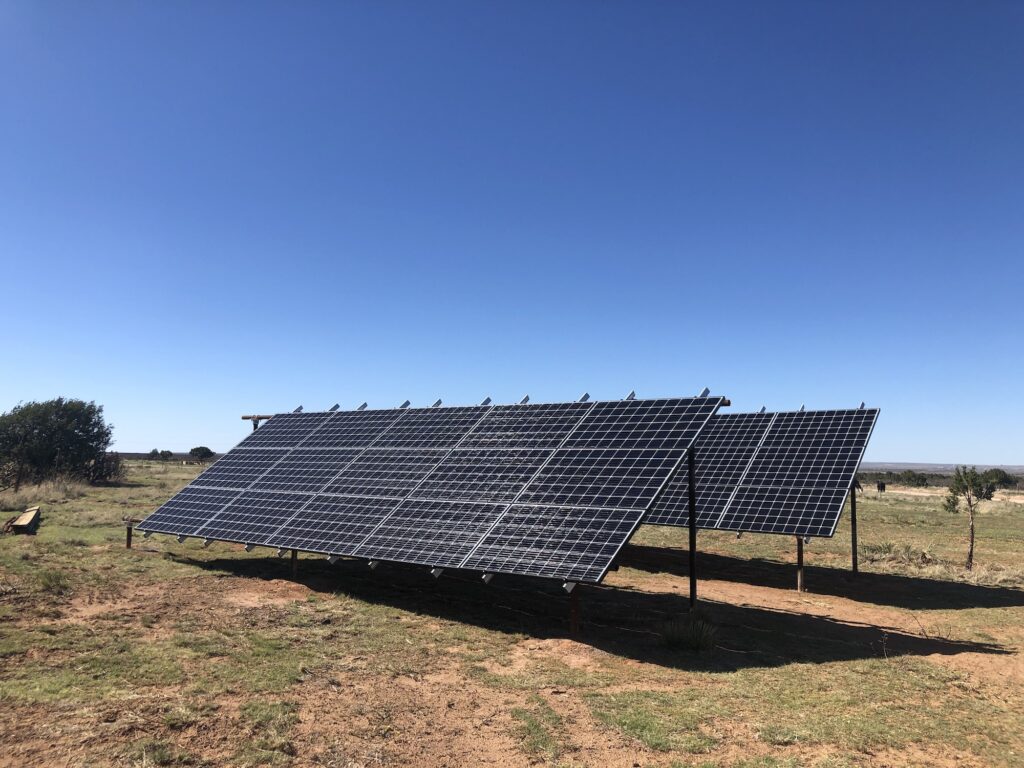
May 21, 2025 | Txses Impact
By Raina Hornaday.
Agrivoltaics—the practice of using land for both solar energy generation and agricultural production—is gaining momentum in Texas as a win-win strategy for sustainable development. As the Lone Star State grapples with rapid population growth, rising energy demand, and the ongoing loss of farmland, agrivoltaics presents a compelling vision: why choose between solar and agriculture when you can do both on the same acres?
American Farmland Trust: Defining and Advancing Agrivoltaics
The American Farmland Trust (AFT) is leading national efforts to define and implement agrivoltaics in ways that work for both farmers and energy developers. According to AFT, a true agrivoltaic system is a ground-mounted photovoltaic array that is intentionally planned and designed with input from agricultural producers or experts to support the simultaneous production of solar energy and marketable agricultural goods throughout the full life of the array—typically 30 to 40+ years.
AFT’s Smart Solar principles call for prioritizing development on built or marginal lands, conserving high-value farmland, and scaling agrivoltaics to help keep working lands productive. Their policy recommendations emphasize the need for clear, farm-centered definitions in state and federal incentive programs, technical assistance for producers, and meaningful community engagement to ensure that agrivoltaics serves both the energy and agricultural sectors.
Solar Grazing: The Texas Model
One of the most tangible examples of agrivoltaics in action is solar grazing—using flocks of sheep to manage vegetation at solar farms. This practice is booming in Texas. Thousands of sheep have been deployed across solar farms as a sustainable alternative to gas-powered mowers and chemical herbicides. Sheep are exceptionally well-suited for this role—they can graze safely beneath and around solar panels without causing damage, while also reducing wildfire risk and naturally enhancing soil health through fertilization and aeration.
For landowners, agrivoltaics creates valuable new revenue streams—lease payments from solar developers, grazing contracts, and continued agricultural production on the same land. As one Texas rancher shared, “We’re not losing anything… we’re just doing it differently.” This dual-use model helps “drought-proof” and “market-proof” farm income, offering economic resilience for rural communities.
Research and Land Management
Incorporating agrivoltaics in utility-scale solar emphasizes biodiversity, long-term stewardship, and community collaboration—working closely with landowners to ensure each project is a good neighbor. Meanwhile, academic research demonstrates that agrivoltaics can reduce land-use conflict, increase water retention, and even boost crop yields—particularly in arid and semi-arid areas like much of Texas.
Policy: Oklahoma’s Agrivoltaics Act
Oklahoma is now charting its own path with the first proposed legislation in the country. The Oklahoma Agrivoltaics Act (HB 2157), currently in conference committee, seeks to align renewable energy development with agricultural productivity. The bill would establish a 17-member Agrivoltaics Advisory Committee—including representatives from agriculture, renewable energy, Tribal governments, and forestry—to guide policy and best practices.
The legislation acknowledges that agrivoltaics can enhance agricultural productivity, particularly in dry regions where photovoltaic shading improves soil health and reduces water loss. Oklahoma, with its vast agricultural landscape and expanding solar industry, is well-positioned to benefit from this integrated approach.
Together, Texas and Oklahoma are modeling how states with deep agricultural roots and strong energy ambitions can create smart, sustainable policies that promote dual-use land strategies.
The Big Picture: Texas at the Agrivoltaic Frontier
With vast solar potential, a thriving agricultural economy, and trailblazing efforts like those at The University of Texas Rio Grande Valley, Texas is poised to become a national leader in agrivoltaics—provided policy support and public engagement continue to grow. The benefits are broad: economically, agrivoltaics reduces operating costs and diversifies rural income; environmentally, it improves soil health, reduces emissions, conserves water, and enhances biodiversity; operationally, it supports vegetation management, mitigates wildfire risk, and improves community perception of solar projects by preserving working lands.
As interest in agrivoltaics accelerates, strong collaboration between the energy and agriculture sectors—bolstered by academic research, responsive policy, and grassroots leadership—will be essential. Texas has a unique opportunity to show the world how to harvest the sun twice: once for clean power, and once for productive, resilient agriculture.
Education on Agrivoltaics: CleanTX and Solar Austin
In celebration of Earth Day, CleanTX and TXSES local chapter Solar Austin, co-hosted an educational event in Austin that brought together solar professionals, ranchers, advocates, and researchers. The program featured a solar sheep rancher, an operations and maintenance director, a local agrivoltaics installer, and a PhD student who wrote his dissertation on the topic. Together, they offered a holistic perspective on the promise and challenges of agrivoltaics in Texas.
Raina Hornaday is a Texas Solar Energy Society board member, a fifth-generation rancher, and an advocate for renewable sustainable land use in Texas.
Photo by Jeff Peterson of Pastoral Solar Land in San Saba; sheep and solar panels on a farm in Bastrop County, Texas
Aug 20, 2022 | Txses Impact

Raina Hornaday
Born into a farming/ranching family in eastern New Mexico, Raina Tillman Hornaday has been a key player in Texas renewables. Currently General Manager and Co-Founder of Caprock Renewables since 2015, Raina spent more than 10 years as GM and co-owner of Cielo Wind Power, the largest independent wind developer in Texas with more than 1 GW of operational projects. She’s been a board member of the Texas Renewable Energy Industries Alliance and CleanTX. Incredibly busy running a business and parenting, Raina was gracious to talk with us about her work.
TXSES: How did Caprock Renewables come to be?
RH: I come from a farming and ranching background in eastern New Mexico. In fact, the Caprock formation is where our family’s homestead is located. Because of that upbringing, I developed a strong connection to the land and earth stewardship. There are immense environmental challenges out there. I like to say that landowners are the ultimate environmentalists because we deal daily with the elements: water, wind and sun to the extreme. Next to drought, wind was and still is a huge factor in our lives. The wind starts building in Roswell and by the time it reaches the Caprock, it takes off! Before grid transmission, every farmer and rancher had wind generators that produced electricity and pumped water from wells. In the 1980s, my dad partnered with a California wind company that installed an 80-meter meteorological (MET) tower to gather data. I founded Caprock in 2015 to help landowners take advantage of additional income by harnessing renewable resources.
TXSES: Did the MET tower inspire you to pursue renewables?
RH: I was a farm and ranch writer for a rural newspaper publication. In that capacity, I was invited to attend the Texas Renewable Energy Roundup in 2002 where I met several wind developers who I still work with today. We signed a lease with RES and provided the met data we gathered over the years from our dry land wheat farm. In 2004, Cielo Wind Power purchased the development and built the Caprock Wind Ranch. I managed operating assets for Cielo, developed a large number of utility-scale wind projects in ERCOT and established an office and business in Santiago, Chile as well. I established an Earth Day Scholarship program to support local communities we partnered with and enjoyed working with the landowners we partnered with. When I left Cielo in 2015, I became active with the Texas Renewable Energy Industries Alliance and still serve on the board of CleanTX who we merged with in 2020.
TXSES: Things have gone well for you. Tell us about some of your projects.
RH: We’ve been busy! Over the past decade, we’ve developed more than 1,000 MW of solar and storage projects throughout ERCOT. Two of our developments were recently acquired by Lightsource BP and ENGIE North America.

10kW ground mount at Raina’s ranch in Eastern New Mexico
TXSES: Being a landowner developer, you have unique insight into working with other landowners.
RH: I really love being involved with the community. As a landowner and developer, I understand the long-term commitment that comes with a renewable development agreement and the importance of going over them with landowners. The farming/ranching industry is changing. The future generations are not necessarily staying on the farm. They are going to college and often not going back home. And then there is the drought. But renewable energy can save the day, over and over. When I work with school districts and counties, I see what a great opportunity they have to work with the large renewable energy companies. Over their lifetime, the current fleet of utility-scale wind and solar projects in Texas will generate between $4.7 billion and $5.7 billion in new tax revenue for local communities. We can also provide resources for the schools to help them educate the students about the rich energy resources in Texas including renewables.
TXSES: Aren’t you interested in agrivoltaics?
RH: Yes! In fact, it’s the capstone project for my master’s in energy from Texas Tech. It will also be a white paper for CleanTX. I’m working with farmers and with the growth of utility-scale solar in Texas, it couldn’t be a more opportune time to promote agrivoltaics to increase pollinators as well as to stabilize the soil. This is my pet project! On large solar installations, we’re taking hundreds of thousands of acres out of production. This makes agrivoltaics crucial! According to the National Renewable Energy Laboratory, solar is expected to utilize 3 million acres of land by 2030 and 6 million by 2050. Planting native crops beneath the solar panels is an innovative technology that helps farmers utilize their farmland to produce renewable energy without abandoning the land. Crop yields and increased economic opportunity are all benefits of agrivoltaics.
TXSES: What’s your workforce look like? What kinds of skills do you look for when staffing?
RH: We’re a boutique developer. We assemble large projects for IPP’s (independent power producer) and utilities to build, own and operate. My top need is always for project managers. It’s highly competitive because they’re in high demand.
TXSES: Is it a challenge being a small boutique developer competing with the big boys?
RH: That’s definitely a challenge. Large developers have much greater resources than we do. But even more of a challenge is having good, sound policies that support our work financially. It’s why we talk about the ‘solar coaster.’ There have been so many starts and stops with the ITC (investment tax credit) and the PTC (production tax credit), but with the passage of the Inflation Reduction Act, we finally have some certainty and can plan with more confidence.
TXSES: What’s surprised you the most with your work?
RH: The lack of policies around development. Projects carry a lot of risk which make them challenging to find and secure the funds needed to develop the projects. Also, the amount of global interest in renewable development in ERCOT.
TXSES: Where do you see Caprock Renewables in five years?
RH: Now that we have successfully developed several projects, we will focus on the development of the other projects in our pipeline. We will also continue to evolve by reviewing the services we offer. We receive many requests from landowners, investors and other developers to provide development consulting as well as to expand our offerings to O&M and asset management. We’ve also considered adding C&I (commercial and industrial) and possibly a residential arm into our portfolio.
TXSES: Lots of work ahead! Thanks for the conversation, Raina. Best of luck!!
www.caprockrenewables.com



